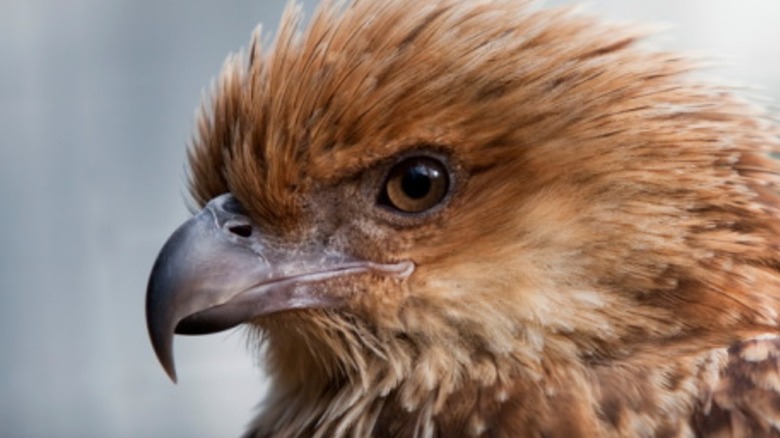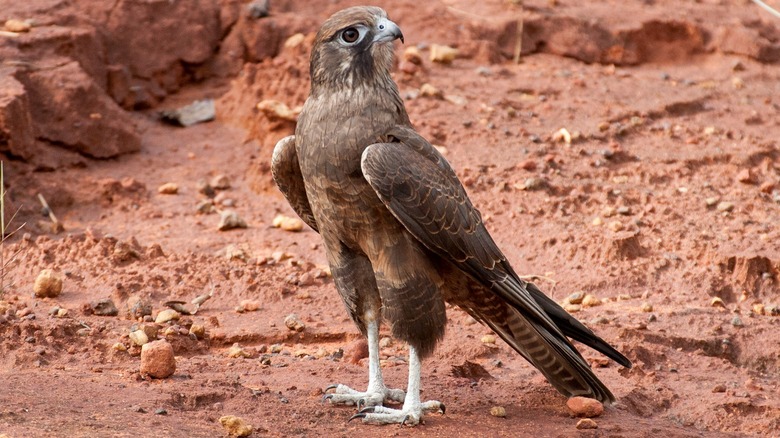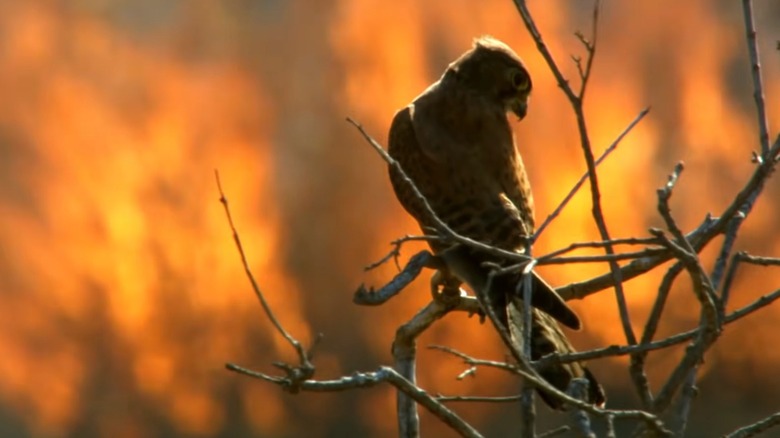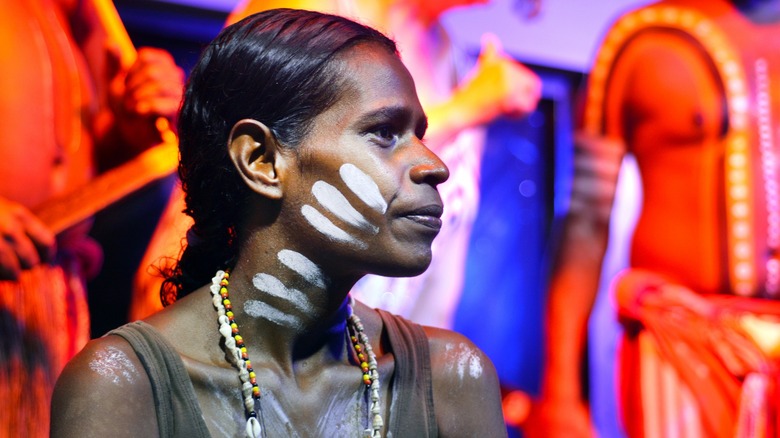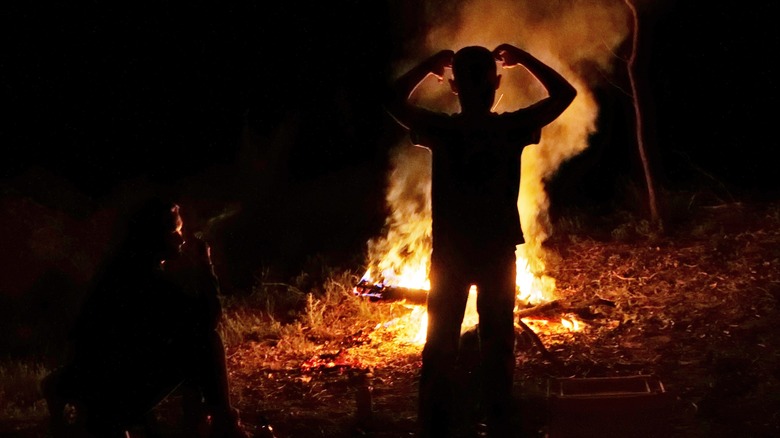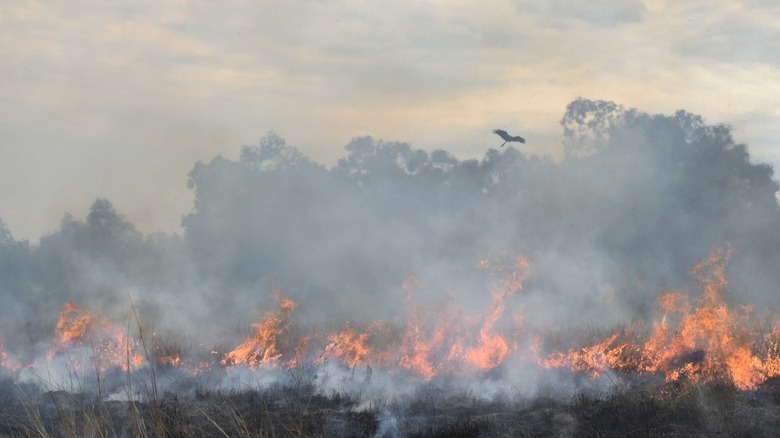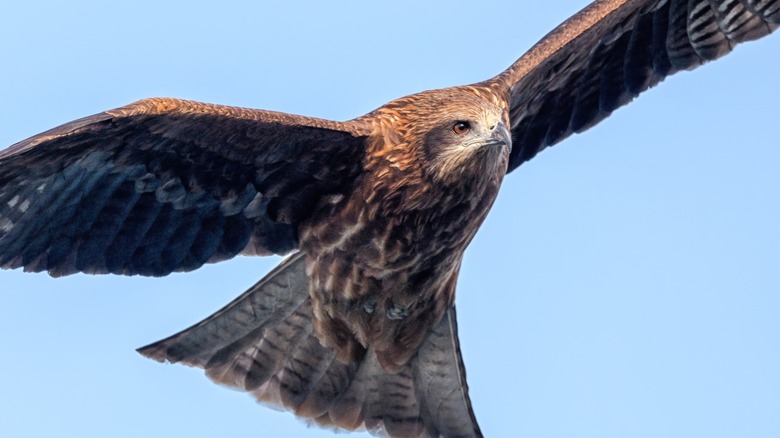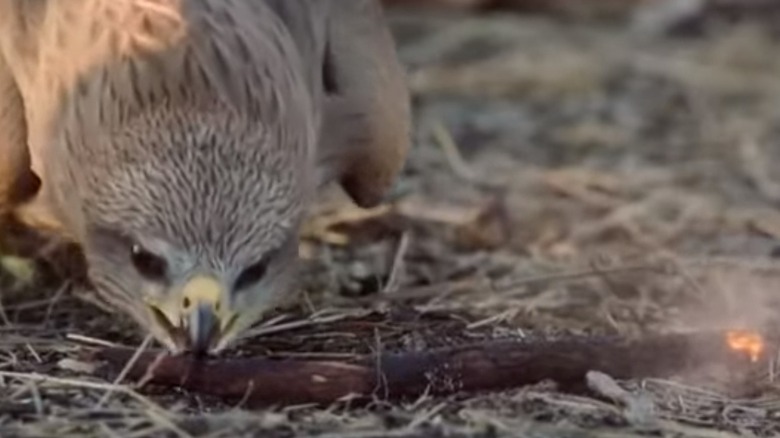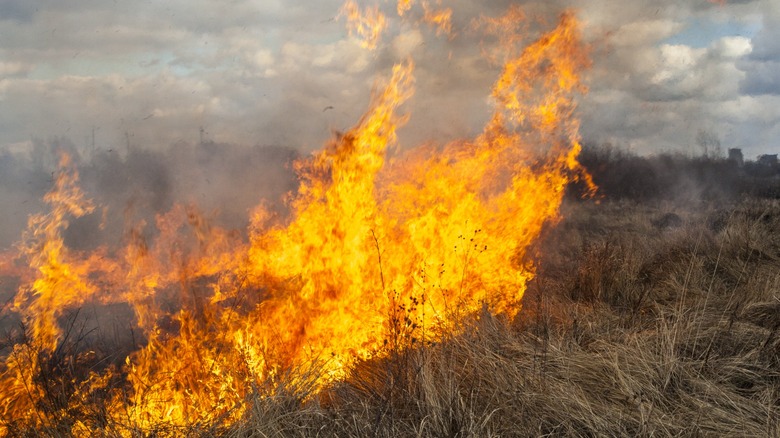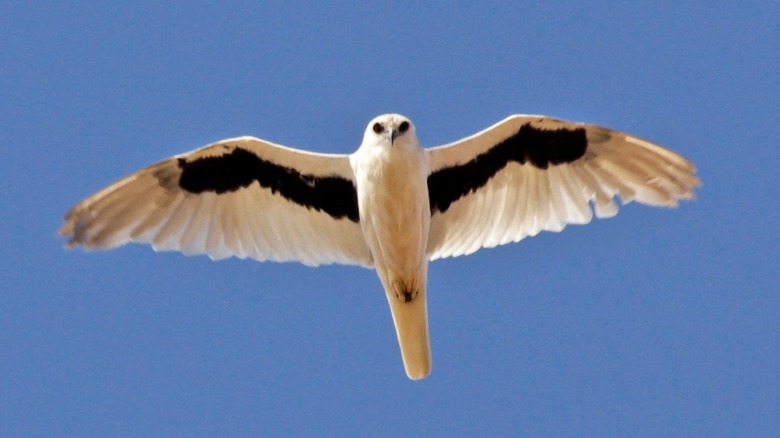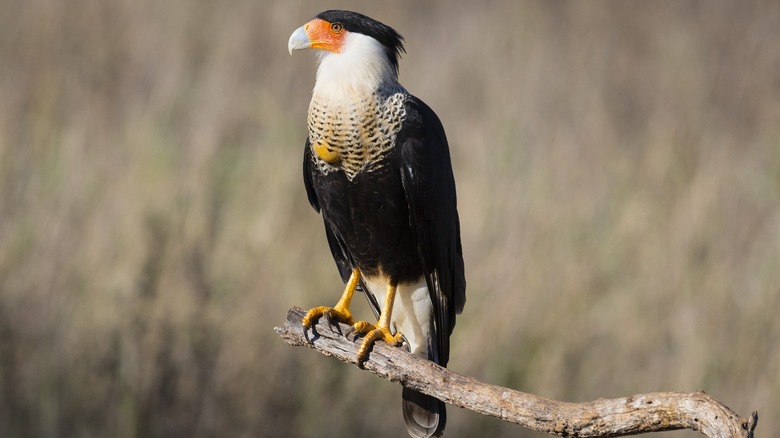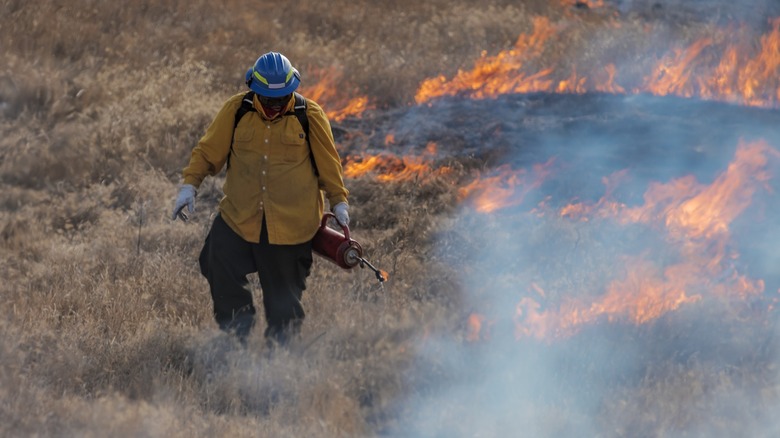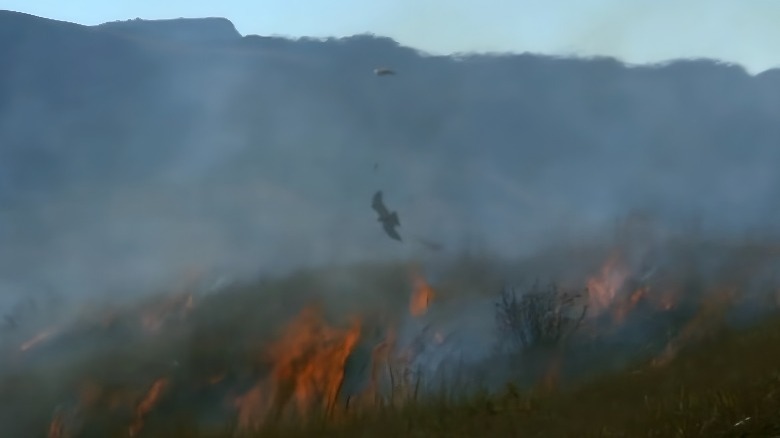The Untold Truth Of Firehawks
While we humans think we have it all figured out, every now and then nature surprises us in a big way. Orcas start flipping yachts, hot pink grasshoppers emerge just in time for the "Barbie" movie, mysterious golden lifeforms turn up on the bottom of the ocean, and countless new species are discovered hiding right under our noses. And the list goes on! Still, some abilities are considered so unique to Earth's current apex species — us humans — that it would seem unimaginable, impossible, and maybe even a little scary if another creature were to accomplish them.
A mastery of fire is one such skill. Yet, it seems that some arsonist birds have, like humans, figured out how to wield flames to their benefit. Firehawks – also called firebirds – are raptors that pick up smoldering sticks from existing fires in their bills or talons and drop them elsewhere, either intentionally or accidentally starting new blazes. These conflagrations, deemed "ornithogenic fires," drive out frightened animals that they then eat.
Though deeply enmeshed in Indigenous Australian culture, this so-called avian fire-spreading is still viewed with a mix of awe and skepticism. Why? Because as of 2023, it's only supported by anecdotal evidence. All that said, the information that we do have on these incredible birds is fascinating to say the least. Here is the untold truth of firehawks.
Several bird species act as firehawks
Surprisingly, fire-wielding doesn't seem to be a behavior confined to a single bird species. Following an in-depth investigation into both ancient Indigenous and modern sightings of firehawks published in a 2017 study in the Journal of Ethnobiology, researchers identified three different predatory Australian bird species that fall under the umbrella name of "firehawk:" the black kite, whistling kite, and brown falcon (pictured).
While firehawks are currently best documented in the wildfire-prone tropical savannas of Australia, other raptors, like crested caracaras, grasshopper buzzards, square-tailed kites, and brown goshawks, have been observed engaging in similar fire-spreading behavior elsewhere on the planet. All firehawks are medium-sized birds of prey that, with their hooked bills, earth-toned plumage, and preference for meat, seem pretty similar. But there's a plot twist. Thorough genetic analyses published in Science in 2008 and 2014 determined that the orders Falconiformes (including falcons and caracaras) and Accipitriformes (including kites, hawks, and buzzards) are not very closely related, evolutionarily speaking.
This means that the firehawks' similar appearance and behavior, including fire-spreading, are the result of convergent evolution: a fancy way of saying that nature came up with the same solution to a problem shared by two separate lineages. That's right, fire use by birds has likely arisen multiple times. For an easy illustration of this phenomenon, consider sharks and dolphins. Though they are not closely related – one is a fish and one is a mammal – both have evolved similar streamlined bodies to facilitate life in the water.
Firehawks take fire foraging to another level
Many animals – including foxes, coyotes, hawks, cattle egrets, vultures, dragonflies, insect-eating birds, and marabou storks – take advantage of active fire fronts, hunting the plethora of animals fleeing from, disabled by, or killed in the flames. When they see smoke, these opportunistic predators often move toward dangerous fires instead of away, in the hopes of snagging an easy meal. This daring and resourceful feeding strategy is known as fire foraging, and has been observed worldwide.
According to a 2017 study published in the Journal of Ethnobiology, raptors in particular are notorious fire foragers, frequently gathering in the hundreds to feast on snakes, rodents, insects, and other small prey at the edges of wildfires. Australian firehawks, however, take things one step further by picking up burning sticks and actively spreading fire to new, unburned areas. Sometimes, the birds even work together, appearing to learn quickly by watching one another.
Whether or not it's done intentionally remains heavily debated, but science writer Jennifer Ackerman, the author of "The Genius of Birds," stated on a 2021 episode of "The Birders Show" that she believes it serves a distinct purpose. "It starts a fire in a new area and then that bird gets to be the only one feeding at that area," she explained. "A lot of times at these fires, there's a lot of competition and it really pays to have your own fire going – and the menu of creatures that are fleeing it."
Firehawks have long been a part of Aboriginal culture
While the idea of firehawks is relatively new to the Western world, Indigenous people in northern Australia have known about the birds' fire-spreading behavior for thousands of years. According to a 2017 study published in the Journal of Ethnobiology, firehawks have long figured prominently in Aboriginal Australian culture, and the birds' fire-spreading tactics are even incorporated into several sacred Dreaming ceremonies that honor ancestral beings and the ancient creation process.
In the multiple-day Yabuduruwa ceremony, for example, participants imitate firehawks through elaborate re-enactments, carrying fire from place to place to spawn new fires in what is known as the "Burnt Grass" scene. And, as described in a 2010 study published in Culture, Ecology, and Economy of Fire Management in North Australian Savannas, men pay homage to karrkkanj – the brown falcon – by holding flaming sticks while singing as part of the several night Lorrkkon funeral ceremony. Actual observations of wild Australian firehawks likely directly inspired such rituals and informed many other aspects of Aboriginal life.
In fact, it was ultimately these long-held practices and beliefs that first clued the study's researchers into the avian fire-spreading phenomenon, and such vital and well-preserved Indigenous ecological knowledge provided valuable insight into firehawk behavior and long-term prevalence in the study. "We're not discovering anything," lead researcher Mark Bonta explained to National Geographic in 2018. "Most of the data that we've worked with is collaborative with Aboriginal peoples ...They've known this for probably 40,000 years or more."
Firehawks may have used fire before humans
In addition to inspiring ceremonies, firehawks may have also influenced Indigenous Australian life in more tangible ways. In fact, as one Alawa Aboriginal man named Waipuldanya told it, watching the fire-wielding birds may have literally sparked helpful ideas. In his 1963 autobiography "I, The Aboriginal," ghostwritten by Doug Lockwood, Waipuldanya wrote: "Not only the hawks used the ruse of deliberate grass fires as an aid for hunting. We often did so ourselves, especially towards the end of the long dry season when food was scarce and ten-feet tall speargrass, which burnt readily, was a natural haven for game. It is possible that our forefathers learnt this trick from the birds."
Of course, this would mean that firehawks used fire long before humans did. While the implications of this seem huge, fire use is only the first step in fire control and mastery. Unlike the firehawks, Aboriginals took the next steps and incorporated controlled burns into their daily lives. According to a 2017 study published in the Journal of Ethnobiology, they used so-called "fire-stick farming" to alter the land's vegetation for the purposes of food cultivation and attracting beneficial meat animals, like emus and kangaroos.
Still, in a presentation at the 2015 Raptor Research Foundation (via Crikey), study researcher Bob Gosford acknowledged that firehawks likely did it first: "Humanity's acquisition and manipulation of fire may be a result of the observation of intentional avian pyrophilic behavior rather than solely some relationship with lightning-caused fire."
Many people claim to have witnessed firehawks
Firehawks aren't just relegated to folklore or the distant past. Plenty of individuals claim to have observed raptors engaging in fire-spreading behavior in the present day, too. In their research, published in the Journal of Ethnobiology in 2017, Mark Bonta and Bob Gosford compiled 20 credible modern instances of raptors actively spreading fire in Australia. Between 2011 and 2017, they interviewed firefighters, Indigenous people, anthropologists, ranchers, and others who had witnessed the behavior firsthand.
Accounts ranged from the Northern Territory to Queensland to Western Australia and featured detailed descriptions of one or several raptors swooping into advancing wildfires – or, in some cases, cooking fires – picking up burning or smoldering sticks, carrying them up to over half a mile away, and dropping them on unburned areas to start new fires. In many cases, the birds were also seen feasting on prey in the resulting blaze.
In one notable depiction of a 2002 event, a rancher named MJ witnessed several kites repeatedly carrying burning sticks across a river where a wildfire was stopped, essentially helping the fire continue its trajectory. It then grew to an inferno that attracted hundreds more kites. Meanwhile, retired anthropologist Kim Akerman has seen firehawks in action multiple times, first in 1977 and again in 1980. "It was great to see," he told the Australian Broadcasting Corporation in 2016. "It's sort of like you know there's dolphins, but when one actually does a somersault in front of you, it's a privilege."
Firehawks are not common (and aren't always successful)
Though the researchers who published their findings in the Journal of Ethnobiology in 2017 are fully convinced that firehawks are real – and a few of them have witnessed them firsthand – they acknowledge that fire-spreading does not seem to be extremely common. After six years of diligently combing through old records and interviewing witnesses, the team only managed to document 20 credible firehawk sightings. Though raptors often gather in flocks hundreds strong at fires to feast on fleeing prey, it seems that only a few ever attempt to start fires of their own.
Still, most people who have seen firehawks picking up flaming sticks and dropping them elsewhere felt that the birds were clearly starting fires deliberately – or at least attempting to. In some cases, a raptor would carry a stick a short distance and drop it in an area where it couldn't burn. In others, the dropped stick would simply fail to ignite a new fire. This has led some to believe that the behavior is indeed real, but merely happens accidentally as the frenzied birds grab at prey with their talons.
In 2011, skeptical park ranger Anthony Molyneux took to the blog of Bob Gosford – one of the study's researchers – to lay it out plainly. "If [hawks] have missed the prey and perhaps grabbed a stick ... they will then drop that stick," he wrote (via National Geographic). "If the stick is smoldering or on fire, it will then start another fire."
Firehawks demonstrate new levels of avian intelligence
Despite the outdated derogatory term "bird brain" still floating around, birds are actually remarkably smart. In fact, several species are regularly lauded for their insightful behavior, tool use, and problem-solving skills, particularly when it comes to finding food. Gulls drop clams on pavements to crack them open, ravens can solve complex puzzles to access rewards, and some parrots have even mastered effective language, allowing them to communicate directly with humans.
Given these impressive feats, it's not that far-fetched to think that birds could be capable of deliberately starting fires, especially considering that black kites – one of the three main firehawk species – are known to bait fish with bread. It's possible that for these opportunistic predators, fire is simply another hunting tool – though it's a tad more dangerous than bread. Still, mastery of fire has long been viewed as a skill reserved for humans – and arguably some chimpanzees.
But that could change. "Many species may have learned to respond to natural fire by escaping from it or exploiting it to hunt fleeing prey," animal behavior expert Alex Kacelnik explained to Cosmos Magazine. "But these hawks are showing a form of fire control." Should researchers prove that fire-starting is intentional, firehawks could potentially blow the lid off everything we think we know about avian intelligence. Speaking about the birds' behavior in his book "Animal Artisans," Michael Allaby wrote: "We are not alone in taking that first step, which in our case led to farming."
There's still no hard evidence of firehawks
While many people claim to have seen firehawks in action, there's a big problem. As of 2023, no known photographic or video evidence yet exists to support the behavior – likely because obtaining such footage requires hanging out near active fire fronts, a dangerous pursuit only regularly attempted by firefighters. Unfortunately, this lack of hard proof relegates avian fire-spreading to the realm of myth and legend, like Bigfoot.
As a result, firehawks are still viewed with skepticism by a significant portion of the scientific community. But a team of researchers is trying to change that. In addition to publishing a study compiling firsthand witness accounts of the birds' fire-starting behavior in the Journal of Ethnobiology in 2017, they are staking out fire fronts alongside firefighters, initiating and monitoring controlled burns, and soliciting photo and video proof from a wide net of potential witnesses.
The researchers are confident that compelling evidence will turn up eventually, proving to the skeptics what many already know to be true. "For ethno-ornithologists, the rather paternalistic, 'It isn't true unless and until Western scientists confirm it' is a real can of worms," the study's lead researcher, Mark Bonta, lamented (via fellow researcher Bob Gosford's blog on Crikey). As for when such proof will come, Bonta told National Geographic in 2018: "It's only a matter of time."
Some Australian ranchers shoot firehawks
While many dispute the very existence of firehawks, some Australian cattle ranchers believe in them to the extent that they even take up arms against them. Negative views toward the birds have also crept into the cultural nomenclature: As a 2017 study published in the Journal of Ethnobiology noted, an unflattering alternative name for firehawks in Australia is "s***hawks." You see, not everyone sees a bunch of pyromaniac birds as remarkable and captivating examples of avian intelligence. For some, stopping firehawks isn't personal, it's purely a matter of fire suppression and livestock protection.
Several cattle ranch workers admitted to the researchers that they regularly shoot all raptors that gather at fires, in an attempt to stop the flames from spreading and harming their land and cattle. While understandable from a business perspective, this is both illegal and detrimental, especially to rare species – like letter-winged kites (pictured), square-tailed kites, and peregrine falcons – that get mixed up in the flock. As lead researcher Mark Bonta and his team continue to investigate firehawks, they are also gathering data on the illegal killing of raptors by ranchers. As noted in the study, one goal of their research is to identify better strategies for managing and living alongside these fascinating birds.
Firehawks aren't unique to Australia
While firehawks are currently most commonly discussed and studied in northern Australia, avian fire-spreading behavior has been described worldwide. According to a 2017 study published in the Journal of Ethnobiology, raptors in Africa, Papua New Guinea, Brazil, Panama, and even Florida and Texas in the United States have also been observed starting fires – and it's not always the same species doing it, either.
In Africa, for example, the grasshopper buzzard is a known fire starter, while in the southern U.S., the crested caracara (pictured) occasionally dabbles in arson. It's also worth noting that the black kite – one of the three main species considered under the umbrella of "firehawk" – occurs on four continents and is one of the world's most numerous and widespread raptors. This basically means that anytime a fire rages where black kites live, the possibility of ornithogenic fires exists.
What's more, fire-spreading can also arise spontaneously within a population of raptors. As animal behavior expert Alex Kacelnik explained to Cosmos Magazine, the birds may occasionally "rediscover" their ability to start fires, then inadvertently teach it to youngsters that watch the behavior in action. It's also possible that additional species may start using fire, either by observing other species doing it, or by reasoning and strategizing on their own in a behavioral process called insight. So, in theory, firehawks can pop up pretty much anywhere opportunistic fire-foraging raptors live.
Fire managers consider them a potential risk
Of all the people out there, Australian firefighters probably have the most direct and comprehensive experience with firehawks. Why? Because, like the predatory birds, they spend a lot of time in close proximity to raging fires. As noted in a 2017 study published in the Journal of Ethnobiology, many firefighters claimed to have observed firehawks actively starting new fires. In fact, they even consider them an impediment to fire control and a potential hazard on their own.
Because of their penchant for helping fire cross barriers like roads and streams, firehawks can spread existing wildfires farther and wider, seriously hampering containment efforts. In the absence of other explanations, some fire managers also attribute the seemingly spontaneous reignition of previously extinguished fires or mysterious containment line jumping to the birds, even if they didn't directly witness avian fire-spreading themselves.
As wildfires become more prevalent due to climate change, it's more important than ever that these legitimate concerns are addressed. With this in mind, widespread scientific acceptance of avian fire-spreading behavior was a primary goal of the 2017 study, so that fire ecologists and land managers can more effectively incorporate firehawk behavior in their planning. As lead researcher Mark Bonta explained to The Wildlife Society in 2018, rangers already take the birds into account when managing ecosystem fuel loads in northern Australia.
Firehawk sightings could increase due to climate change
Firehawks flock to fires, and, unfortunately for the rest of us, these are not in short supply in modern times. Climate change is creating hotter and drier conditions across much of the globe, extending fire seasons and contributing to more frequent and severe wildfires. In 2023, we have only to look to Maui and Canada to see that this is true, even in areas where devastating fires are historically rare.
Australia – where firehawks are most widely reported – had its worst fire season on record from 2019 to 2020, losing 46 million acres to the unstoppable blazes. Though bushfires are part of the country's natural ecology, the relentless intensity brought on by excessive heat and drought made it far more destructive and catastrophic than usual. And it's not likely to get any better: According to a 2022 report by the United Nations Environment Programme, extreme fires are expected to increase by 50% worldwide by the year 2100.
With the increased prevalence of fires, we could see more firehawks – whether the three currently documented species or others – breaking out of the flock to harness the flames. Drier conditions will surely increase the birds' chances of success, as they practically guarantee that every smoldering stick will kindle a new fire. For better or worse, eventual photo or video proof of the behavior seems inevitable.
